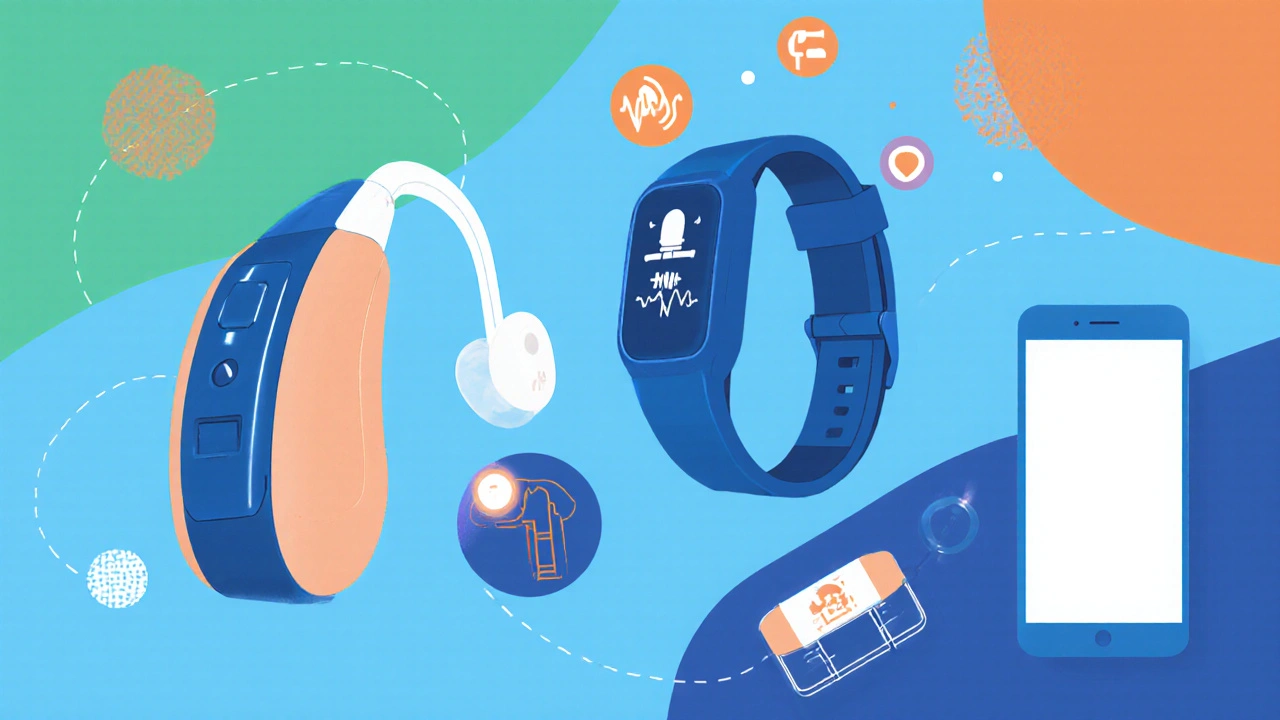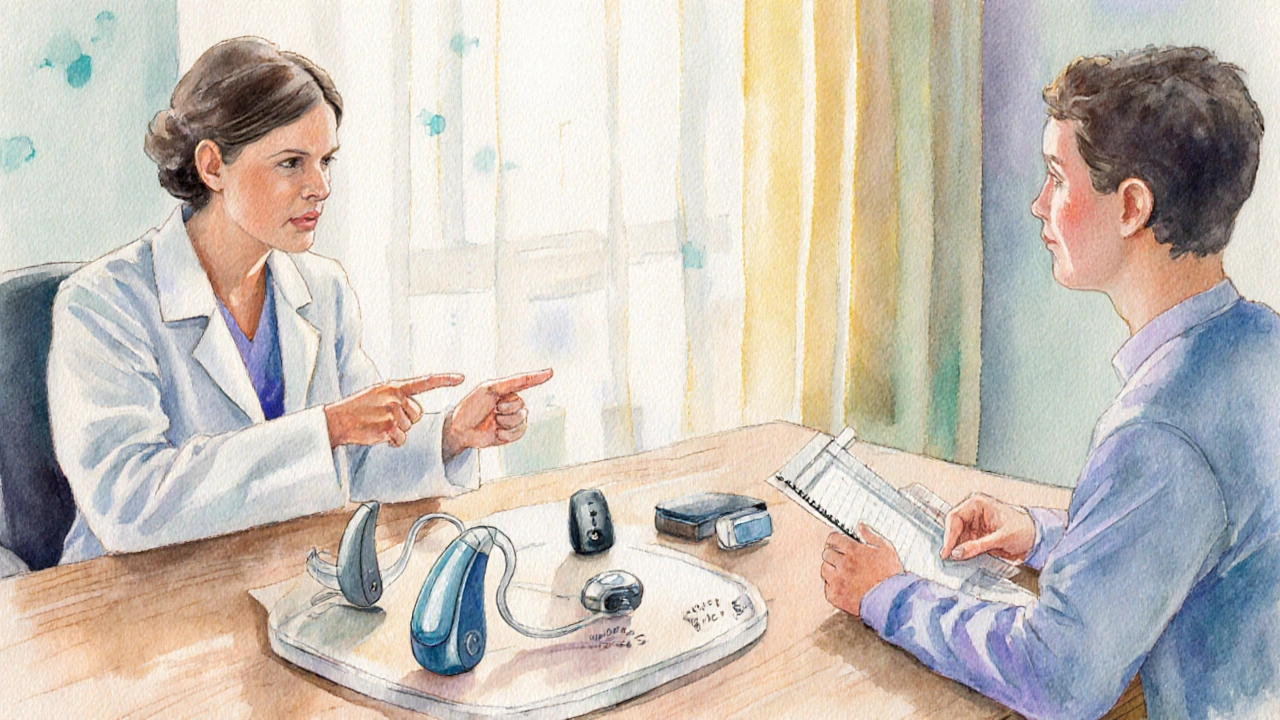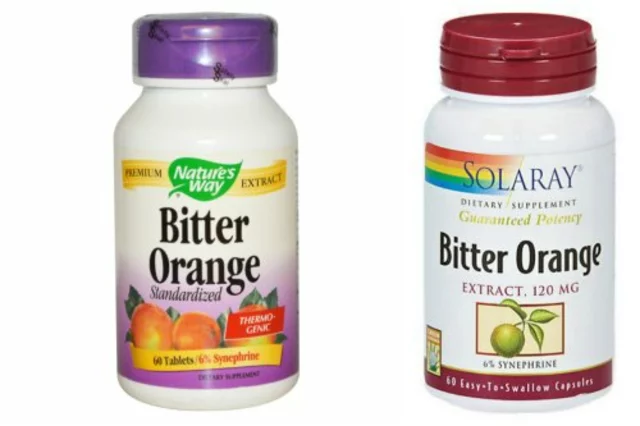Meniere's Device Finder
Find Your Best Assistive Device
Answer a few questions about your symptoms and lifestyle to get personalized device recommendations
Your Recommendations
Living with Meniere's disease is a daily juggling act between sudden vertigo, fluctuating hearing loss and ringing ears. Thousands of Australians cope with the unpredictable attacks, but the right assistive tools can turn chaos into a more manageable rhythm.
Key Takeaways
- Meniere's disease combines vertigo, tinnitus, aural fullness and hearing loss.
- Assistive devices focus on three core needs: hearing support, balance stability, and symptom monitoring.
- Choosing a device starts with symptom severity, lifestyle, and budget.
- Regular follow‑ups with an ENT or vestibular therapist keep devices effective.
- Simple habits-low‑sodium diet, stress reduction, and consistent device use-boost outcomes.
What Is Meniere's Disease?
First described by French physician Prosper Menière in 1861, Meniere's disease is a chronic inner‑ear disorder that causes episodes of vertigo, fluctuating sensorineural hearing loss, tinnitus, and a feeling of fullness in the affected ear. The condition typically appears between ages 30 and 60 and affects about 12 per 100,000 people worldwide.
The exact cause remains elusive, but excess fluid (endolymph) in the cochlea and vestibular labyrinth is the prevailing theory. Triggers such as high‑salt meals, caffeine, stress, and certain medications can worsen the fluid imbalance.
Why Assistive Devices Matter
When vertigo knocks you off your feet, or when hearing fades during an attack, everyday tasks become risky. Assistive devices fill the gaps left by the inner ear, letting you stay active at work, home, and social gatherings. They also provide objective data-like attack frequency-that helps doctors fine‑tune treatment plans.

Top Assistive Tools
Below is a quick rundown of the most common categories, each aimed at a specific symptom cluster.
1. Hearing Aids
Hearing aid is a small electronic device that amplifies sound, making speech and environmental noises clearer for people with hearing loss. Modern digital models adapt to noisy settings, focus on speech, and can be paired with smartphones for direct streaming.
- Best for: fluctuating low‑frequency loss during attacks.
- Key features: directional microphones, tinnitus masking, rechargeable batteries.
2. Balance Aids
A balance aid can be as simple as a sturdy cane or a high‑tech wearable that provides real‑time gait feedback.
Balance aid refers to devices such as canes, walkers, or electronic stabilisers that help maintain postural control during vertigo episodes. Wearable gyroscopes alert you via gentle vibration when your sway exceeds a safe threshold.
- Best for: people who experience sudden drops in equilibrium.
- Key features: lightweight frame, anti‑slip tips, vibration alerts.
3. Mobile Apps & Wearables
Smartphone apps designed for vestibular disorders let you log attacks, track diet, and run guided vestibular rehabilitation exercises.
Smartphone app is a mobile application that records symptom data, provides reminder notifications, and offers exercises to improve vestibular function. Many integrate with Apple Health or Google Fit for a holistic view.
- Best for: tech‑savvy patients who want data‑driven insight.
- Key features: push alerts for low‑sodium meals, vertigo‑trigger logs, video‑guided balance drills.
4. Vestibular Implant
For severe, refractory cases, a vestibular implant works like a cochlear implant but targets balance signals.
Vestibular implant is a surgically placed device that electrically stimulates the vestibular nerve to restore a sense of balance in patients with profound vestibular loss. Only a handful of Australian centres offer it under clinical trials, but early results show reduced vertigo frequency by up to 80%.
- Best for: patients with chronic disabling vertigo unresponsive to medication.
- Key features: programmable stimulation settings, MRI‑compatible hardware.
5. Tinnitus Maskers
Tinnitus can dominate the acoustic landscape during an attack. Dedicated maskers emit low‑level noise to “cover” the ringing.
Tinnitus is the perception of sound-often a ringing, buzzing, or hissing-without an external source, commonly associated with Meniere's disease maskers are either wearable (neckband) or bedside devices that produce pink noise, white noise, or nature sounds.
- Best for: patients whose quality of life is compromised by constant ringing.
- Key features: adjustable volume, multiple sound profiles, Bluetooth streaming.
Comparison of Core Devices
| Device | Primary Symptom Target | Typical Cost (AUD) | Invasiveness | Maintenance |
|---|---|---|---|---|
| Hearing aid | Hearing loss, tinnitus | $1,200-$3,500 | Non‑invasive | Battery recharge, periodic fitting |
| Balance aid (wearable) | Vertigo, postural instability | $150-$600 | Non‑invasive | Battery swap, firmware updates |
| Vestibular implant | Severe vertigo | $15,000-$25,000 (surgery + device) | Surgical | Programming appointments, device checks |
| Tinnitus masker | Tinnitus | $200-$800 | Non‑invasive | Battery replace, sound‑profile updates |
How to Choose the Right Device
Picking a tool isn’t a one‑size‑fits‑all decision. Use the checklist below to narrow down options.
- Identify dominant symptoms. Is vertigo the main blocker, or does hearing loss keep you from conversations?
- Assess severity. Occasional spells may need a simple cane; daily episodes often justify a hearing aid with tinnitus masking.
- Consider lifestyle. If you travel frequently, a rechargeable hearing aid beats a battery‑powered model.
- Budget & insurance. Private health funds in Australia cover a portion of hearing aids but rarely vestibular implants.
- Trial period. Most audiologists allow a 30‑day test; use that window to gauge comfort and real‑world benefit.
- Professional guidance. An ENT, audiologist, or vestibular therapist can calibrate devices and recommend complementary exercises.

Practical Tips for Everyday Use
Even the best gadget needs good habits.
- Log attacks. Use a simple notebook or app to note time, diet, stress level, and device settings. Patterns often emerge.
- Maintain low‑sodium intake. Aim for 1500mg of sodium per day; a diet high in processed foods can trigger fluid buildup.
- Stay hydrated. Proper hydration helps the inner ear regulate pressure.
- Practice vestibular rehab. Daily gaze‑stabilisation and balance drills improve compensation, making devices less critical over time.
- Regularly check battery levels. Unexpected power loss during a vertigo spell can be dangerous.
- Educate family and coworkers. A quick explanation of your device’s function reduces misunderstandings during an episode.
When to Seek Professional Help
If you notice any of the following, schedule an appointment promptly:
- Vertigo lasting longer than 24hours.
- Sudden, permanent hearing loss in the affected ear.
- Severe tinnitus that disrupts sleep.
- Device discomfort, skin irritation, or feedback loops (for hearing aids).
- Failure of symptoms to improve despite lifestyle changes and device use.
Frequently Asked Questions
Can hearing aids worsen Meniere’s attacks?
No. Modern digital hearing aids are designed to amplify speech while reducing background noise. They do not affect inner‑ear fluid dynamics, so they won’t trigger vertigo. However, an ill‑fitted device can cause ear pressure, so professional fitting is essential.
Are balance aids covered by Medicare?
Standard Medicare does not reimburse most balance aids. Some private health policies include a “mobility aids” component that can offset the cost of a sturdy cane or walker. Always check your policy’s fine print.
What’s the difference between a vestibular implant and a cochlear implant?
A cochlear implant restores hearing by stimulating the auditory nerve; a vestibular implant targets the vestibular nerve to improve balance. Both involve surgery, but the implant’s electrode placement and programming goals differ.
How often should I replace the batteries in my tinnitus masker?
Most maskers use AAA or button cells lasting 3‑6months depending on volume. If you notice a drop in sound quality, swap the batteries immediately to keep masking effective.
Is there a risk of infection with a vestibular implant?
As with any implanted device, there’s a small infection risk (≈2%). Surgeons use prophylactic antibiotics and a sterile technique to keep it low. Prompt reporting of redness or drainage is vital.



Victoria Guldenstern
14 October / 2025Living with Meniere's feels like being stuck on a theme park ride that never stops. You get dizzy spells that make you question whether gravity still works. The hearing loss appears for a moment then disappears like a mischievous ghost. And the tinnitus is that relentless soundtrack you never asked for. The article lists assistive devices as if they were optional accessories. In reality they are more like survival gear for a treacherous battlefield. A hearing aid that masks tinnitus can turn a noisy cafe into a tolerable environment. A balance aid with vibration alerts is basically a personal guardian angel for your legs. Mobile apps that log attacks are the digital diaries you never knew you needed. Even the high‑tech vestibular implant sounds like something out of a sci‑fi movie. Yet the price tags read like a cruel joke aimed at anyone without deep pockets. The article wisely mentions insurance but forgets that many policies treat these devices as luxuries. If you truly want to manage Meniere's you must combine lifestyle changes with the right gadget. Low‑salt diet, stress reduction and consistent device use are the trifecta of sanity. So before you click “Get Recommendations” remember that the tools are only as good as the effort you put behind them.